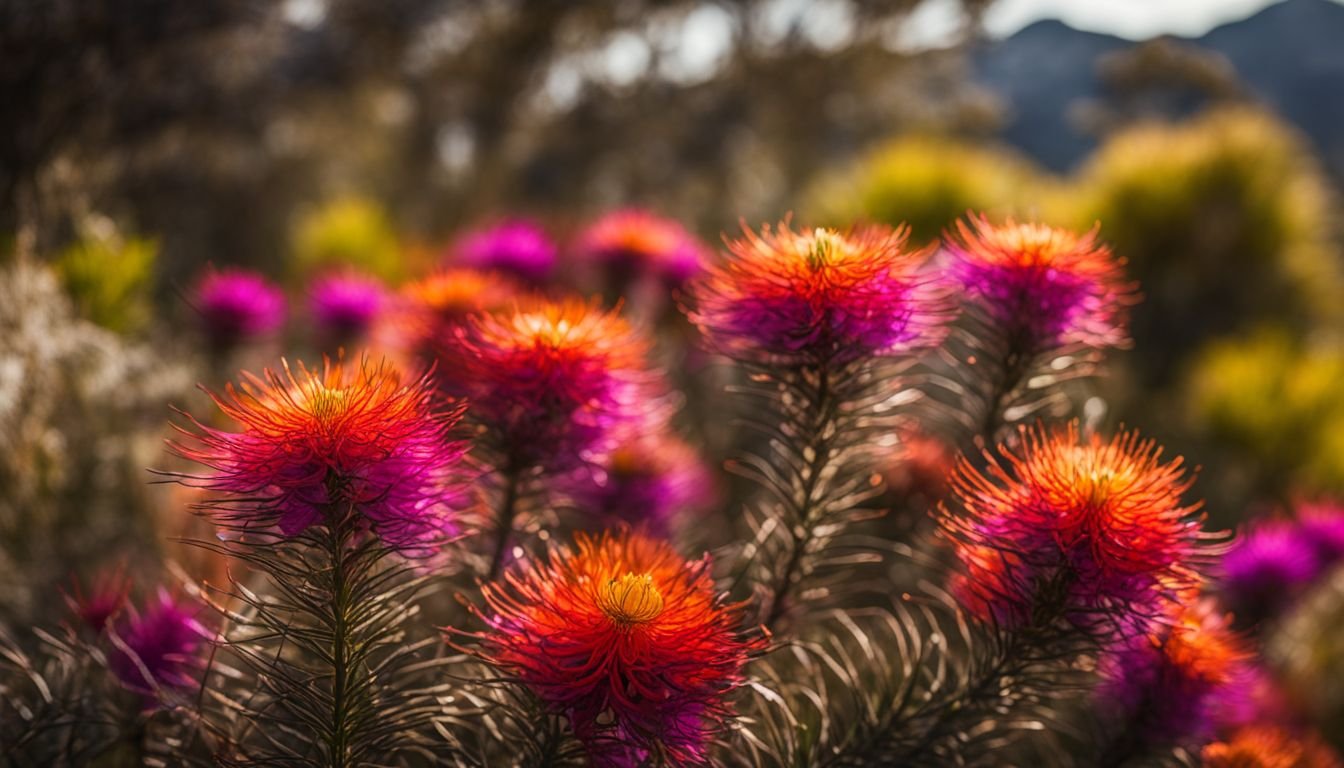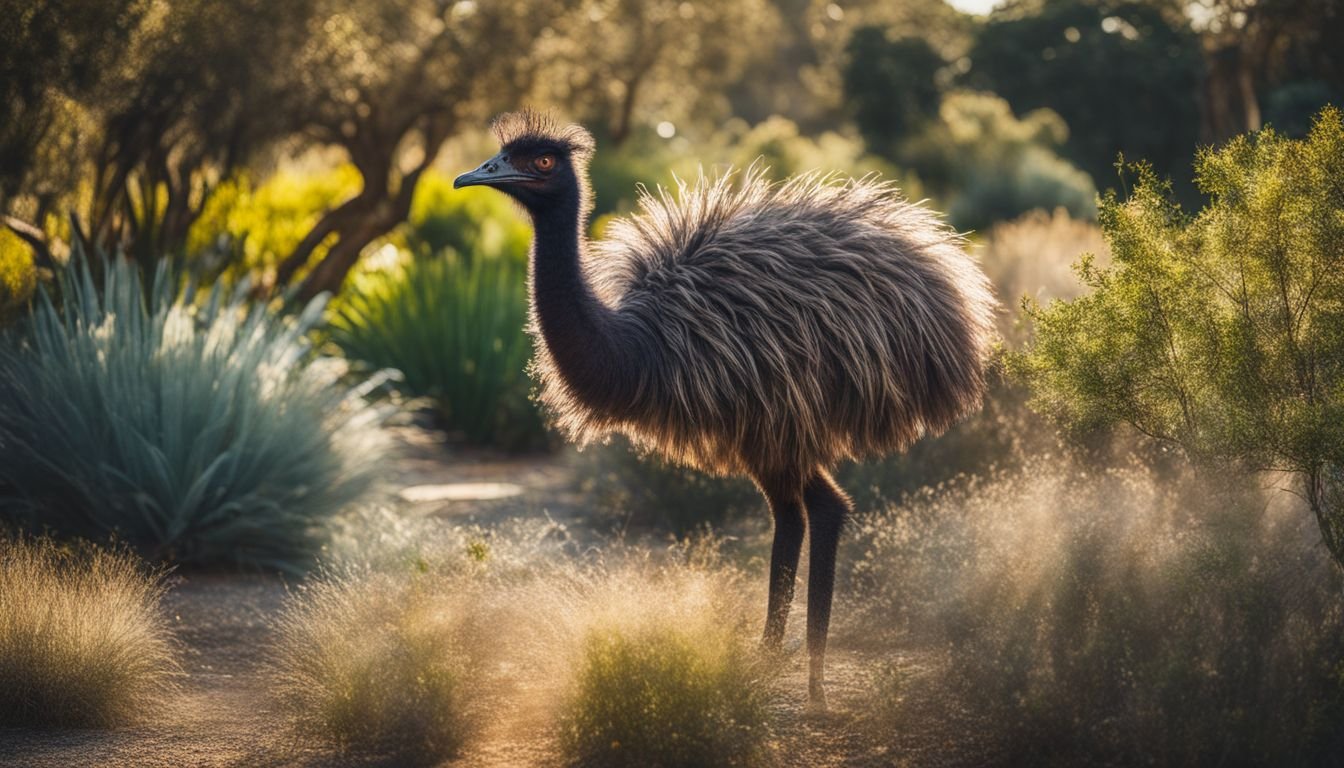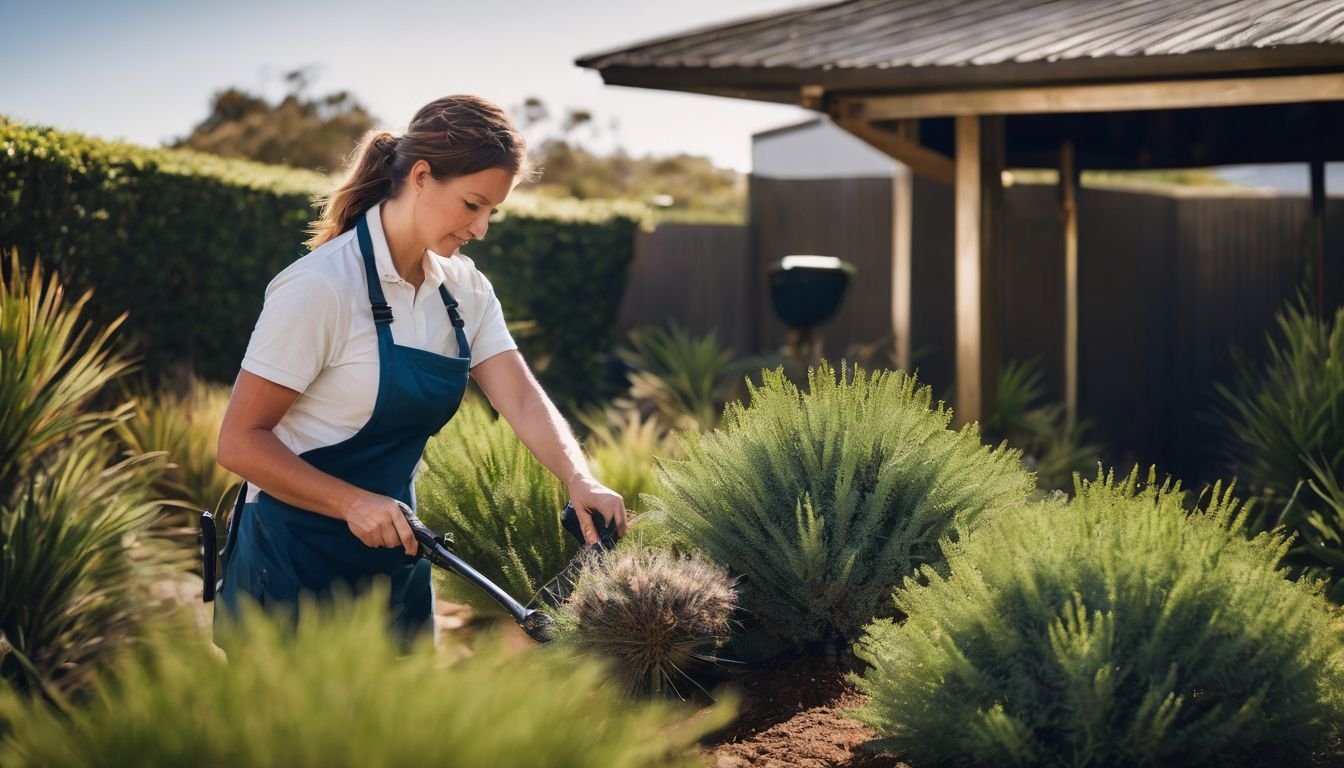Finding the perfect plant for Aussie gardens can feel like trying to solve a tricky jigsaw, especially when you’re chasing something that’s not just a feast for the eyes but tough and easy-care to boot.
It’s a common snag many of us hit, on the lookout for that spot-on addition that brings both good looks and sturdiness to our open-air sanctuaries.
We’ve trodden this path as well, grappling with the same gardening pickles you do. On our hunt, we stumbled across the Emu Bush (Eremophila), an absolute gem from our own backyard celebrated for its striking purple tubular blooms and silvery foliage—a real showstopper in any garden setting.
After diving headlong into research and picking the brains of gardening buffs, we’re chuffed to bits to share how this stunning shrub can give your garden a proper facelift with its unique charm and smashing benefits.
This yarn is your ticket to unleashing the potential of Emu Bush in your own slice of paradise. Keen to have your garden looking mint? Let’s get stuck into it!
Key Takeaways
- Emu Bush, known scientifically as Eremophila maculata, stands out in Australian gardens with its stunning purple flowers and silvery foliage. These plants not only add a splash of color but also attract bees and birds, enhancing garden biodiversity.
- This resilient shrub thrives under tough conditions, showing incredible tolerance to drought, frost, and wind. Ideal for gardeners looking for low-maintenance yet beautiful plants, Emu Bush proves to be a perfect choice across various Australian climates.
- Beyond adding beauty to gardens, Emu Bush holds significant cultural and medicinal value in Aboriginal Australian traditions. It’s used in traditional remedies for colds and skin conditions and plays a role in spiritual ceremonies.
- With its adaptability to different soil types and climates alongside minimal care requirements like light pruning for shape or flower production enhancement—Emu Bush is suitable for all gardening enthusiasts. Whether planted alone or mixed with other natives like bottlebrush or gum trees, it brings unique charm and resilience to landscapes.
- Exploring other native plants such as Boronia, Banksia, Bird’s Nest Fern among others can complement the emu bush beautifully while supporting local wildlife and contributing further to the diversity of your garden ecosystem.
Unique Beauty of Emu Bush

Emu Bush captivates our gardens with its distinctive charm, setting a breathtaking scene throughout the year. Its eye-catching appearance enriches our landscapes, promising a spectacle of colour and texture that truly stands apart.
Silvery Foliage
Our gardens often yearn for a touch of distinction, and the silvery foliage of Emu Bush offers just that. These soft, shimmering leaves catch the light in a way that brings an understated elegance to any Australian garden.
Not only do they stand out with their unique beauty, but they also create a splendid backdrop for the vibrant purple tubular flowers that emerge in abundance. It’s this combination of silver against purple that makes Emu Bush plants captivating feature points in dry landscapes.
We’ve noticed how these silvery leaves are not just aesthetic wonders; they serve as magnets for wildlife too. Bees buzz around them, drawn by their allure while nectar-feeding birds find refuge and sustenance amongst their branches.
This interaction adds life to our gardens, making them thriving ecosystems instead of mere showpieces.
Choosing plants like Emu Bush with such distinctive foliage enriches our outdoor spaces beyond measure. They harmonise beautifully with other Australian natives like bottlebrush and gum trees or can stand alone as striking specimens in pots mixed with quality potting mix and native fertiliser.
Their adaptability and resilience further solidify their status as must-haves for those looking to cultivate an iconic Aussie garden vibe.
Purple Tubular Flowers
We often marvel at the stunning purple tubular flowers of the Emu Bush, which bring a unique beauty to Australian gardens. These vibrant blooms not only add a pop of colour but also play an essential role in attracting bees and nectar-feeding birds, enhancing the biodiversity of our outdoor spaces.
Eremophila maculata, as it’s scientifically known, thrives under the full sun, showcasing its flowers that stand out against its silvery foliage.
Light pruning after flowering ensures these captivating blooms maintain their allure year after year. This practice encourages more vigorous growth and bloom production, keeping the bush healthy and visually appealing.
Additionally, incorporating organic mulch around these plants aids in retaining moisture and suppressing weeds, further contributing to their lush appearance and robust health.
Incorporating such native gems into our gardens supports local wildlife while adding aesthetic value. The drought tolerance of Emu Bush makes it an ideal choice for gardeners seeking low-maintenance yet striking plants.
As we explore various Australian native plants for inclusion in our landscapes, the purple tubular flowers of Emu Bush remain a beloved feature that resonates with both seasoned horticulturists and casual gardening enthusiasts alike.
Benefits of Emu Bush in Australian Gardens

Incorporating emu bush in Australian gardens brings a remarkable resilience against the local climate’s challenges. Its ability to thrive under conditions that would stress many other plants showcases its indispensability for gardeners seeking beauty without the fuss.
Drought, Frost and Wind Tolerant
We’ve discovered that Eremophila Blue Horizon™ stands out not just for its beauty but also for its resilience. This gem thrives in light sandy, free-draining soil, yet it’s tough enough to take on heavier soils if the climate stays dry.
We love how it prefers full sun to light shade, making it versatile for various garden spots. Its capacity to endure drought once established turns gardening into a less water-reliant endeavour.
Eremophila Blue Horizon™ doesn’t stop at drought tolerance; it’s also frost tolerant and battles against wind without breaking a sweat. This makes it an ideal choice for Australian gardens prone to unpredictable weather.
The plant’s adaptability means we can enjoy the lush display of silvery foliage and purple tubular flowers without constant worry about climate extremes affecting our beloved emu bush.
Versatile Growth Habit
Understanding the resilience of Emu Bush against drought, frost, and wind brings us to appreciate another standout feature: its versatile growth habit. This remarkable plant takes adaptability to the next level, thriving in various settings from native and wildlife gardens to striking winter landscapes.
Its spreading growth habit makes it a perfect fit for groundcover applications or contained elegance in pots and containers. Whether you’re aiming to add texture with its silvery foliage or brighten spaces with purple tubular flowers, Emu Bush seamlessly integrates into diverse garden designs.
Incorporating eremophilas into your garden isn’t just about aesthetic appeal; it’s also about cultivating an environment that responds well to care without demanding constant attention.
Pruning in spring enhances its shape and encourages more vibrant flowering, demonstrating how responsive this plant is to simple maintenance efforts. For those seeking a more manicured appearance, pruning every 2-3 years yields excellent results, underlining the emu bush’s flexibility across different gardening styles.
Plus, with suitability across all Australian states and an ability to thrive in light sandy soils as well as heavier conditions in drier climates, eremophilas prove themselves as indispensable additions for both seasoned gardeners and newcomers eager to explore their horticultural passion.
Tailoring your approach allows you not only to enjoy the visual diversity but also leverage emu bush’s adaptability for practical benefits such as erosion control or creating natural barriers within your landscape design.
Opting for grafted plants can introduce even more variety into your garden palette while maintaining drought tolerance – a testament to emu bush’s capability of blending utility with unmatched beauty.
Cultural and Medicinal Uses of Emu Bush
We often admire the Emu Bush for its drought tolerance and striking flowers, but its roots run deeper in Australian culture than many of us realise. Aboriginal Australians have long cherished this plant, integrating it into their medicinal practices and spiritual ceremonies.
They use leaves from the Emu Bush to brew a tea that’s believed to combat colds, coughs, and sore throats. This deep connection highlights not just a utilitarian relationship with nature but a profound respect for the land’s bounty.
Moreover, applying Emu Bush extracts topically has been common for treating various skin conditions and warding off insects – an early form of bush medicine. The plant also takes on roles in smoking ceremonies conducted by Indigenous communities, lending its etheric qualities for spiritual healing purposes.
Beyond its beauty and resilience in harsh climates, Emu Bush stands as a testament to Australia’s rich cultural heritage woven through traditional stories and artworks. As we explore more plants for our gardens, let’s keep unfolding the layers of history each one carries with them into our contemporary spaces.
Discover More Plants for Your Garden
Exploring the beauty of Australian gardens opens up a world of vibrant flora beyond the remarkable emu bush. Let’s dive into a selection of plants that can transform your garden into a thriving haven for wildlife and provide a stunning display throughout the year.
- Boronia – Known for its intensely fragrant flowers, Boronia thrives in well-drained soils and partial shade. This plant adds a delicate touch to any garden, with varieties ranging from pink to brown flowers, bringing an enchanting scent that fills the air in spring.
- Banksia – With its unique cylindrical flower spikes, Banksia is a standout in any garden setting. Adaptable to various soil types, this hardy plant is drought tolerant like the emu bush and attracts birds with its nectar-rich blooms.
- Bird’s Nest Fern – For those shaded or semi-shaded areas, the Bird’s Nest Fern offers lush greenery with minimal fuss. Its broad fronds create an impressive display of green, perfect for adding texture and depth under taller trees or as a striking indoor plant.
- Bottlebrush (Callistemon) – Vibrant red flowers that resemble a bottle brush make this plant impossible to ignore. Thriving in full sun and attracting pollinators such as bees and birds, Bottlebrush is ideal for adding colour and life to your garden.
- Tea Tree (Leptospermum) – Offering more than just visual appeal with its small but striking flowers, Tea Tree also has medicinal properties known among Indigenous cultures for centuries. It loves sunny spots and well-drained soil, making it another resilient choice for Australian gardens.
- Wattle Trees – Symbolising the Australian spirit with their golden blooms, Wattle Trees are fast growers that bring cheer to any landscape. They vary in size from small shrubs to large trees, providing options for every garden space.
- Climbers: Eucalyptus & Fuchsia Bush – To add vertical interest or cover unsightly fences, climbers like Eucalyptus and Fuchsia Bush offer both beauty and practicality. Eucalyptus introduces aromatic leaves alongside visually appealing bark while Fuchsia Bush delights with its pendant-shaped blooms in shades of pink, purple, and white.
Conclusion
Emu Bush transforms Australian gardens with its unique charm and resilience. Its beauty lies not just in the dazzling purple flowers and silvery leaves, but also in its ability to thrive under tough conditions.
This hardy shrub promises a garden that’s both vibrant and wildlife-friendly. With simple cultivation tips, anyone can enjoy the wonderful benefits Emu Bush brings to their outdoor space.
Let’s embrace this splendid addition for more lively and attractive gardens across Australia.
FAQs
1. What makes the Emu Bush a great addition to Australian gardens?
The Emu Bush, with its vibrant Eremophila Amber and Eremophila Nivea varieties, brings stunning colors and unique textures to any cottage garden. Its ease of cultivation from cuttings or seeds also suits the diverse Australian climate nicely.
2. Can you eat parts of the Emu Bush? Is it considered bush tucker?
Yes, certain parts of some Emu Bush species can be consumed and are considered part of traditional bush tucker. However, it’s crucial to identify which parts are safe to eat before consuming.
3. How do you successfully grow an Emu Bush in your garden?
For successful growth, plant your Emu Bush in well-drained soil and ensure it receives full sun exposure. Propagation is effectively done through cuttings or seeds during the right season for robust cultivation.
4. Are there any special benefits that come with having an Emu Bush in my garden besides its beauty?
Apart from adding aesthetic value to your garden with their attractive flowers and foliage, many types of Eremophila offer habitats and food sources for native wildlife, enhancing biodiversity within your garden space.
